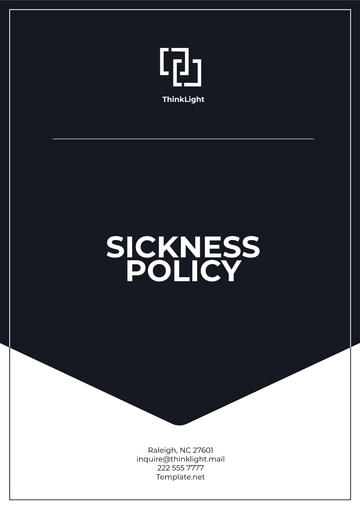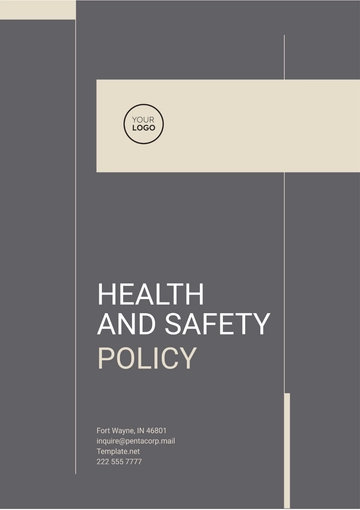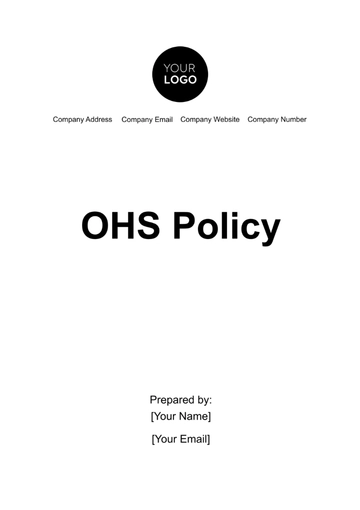Free Animal Care Policy and Procedure

I. Purpose and Scope
A. Purpose
The primary purpose of [Your Company Name]'s Animal Care Policy and Procedure is to ensure that all animals under our care are treated humanely, with a focus on their physical, mental, and behavioral well-being. This policy ensures staff, volunteers, and contractors maintain high-quality care standards in line with veterinary practices and animal welfare regulations, promoting safe animal handling and management.
B. Scope
This policy applies to all animals in the facility, including those housed for medical treatment, rehabilitation, adoption, or research. The policy covers all species—mammals, birds, reptiles, and aquatic animals—and outlines procedures for housing, feeding, enrichment, and health monitoring, as well as the roles of veterinary staff, animal care technicians, and administrative personnel.
C. Objectives
The objectives of this policy are to ensure that all animals are provided with appropriate care and attention according to their specific needs. Our policy prevents animal suffering, improves quality of life, aids rehabilitation or rehoming, and upholds legal and ethical standards to ensure top-level care and responsibility.
II. Definitions
A. Animal Welfare
Animal welfare refers to the overall well-being of animals, taking into account their physical health, emotional state, and ability to engage in natural behaviors. It involves providing food, water, shelter, medical care, and mental enrichment, while also preventing pain and distress in animals.
B. Veterinary Care
Veterinary care encompasses the diagnosis, treatment, prevention, and monitoring of animal health by licensed veterinarians. Veterinary care encompasses regular check-ups, vaccinations, parasite control, and emergency interventions, focusing on both treatment and preventive health for animals.
C. Other Terms
Enrichment refers to providing animals with environmental and behavioral stimuli to enhance their physical and psychological well-being.
Handling involves the safe and humane interaction with animals, including moving, restraining, or medicating them.
Quarantine refers to isolating new, ill, or potentially contagious animals from the rest of the population to prevent the spread of disease or infection.
III. Animal Welfare Standards
A. Basic Welfare Requirements
Every animal under our care must be provided with a clean and safe environment, including appropriate space for movement, exercise, and rest. Each animal should have access to a balanced diet and clean water at all times, along with a comfortable bedding area to rest in. The facility must also ensure that all animals are housed in a secure and controlled environment to prevent escape or injury.
B. Physical and Behavioral Well-being
Animal care staff must conduct regular health assessments, including monitoring weight, physical condition, and behavior to detect signs of illness or distress. Behaviorally, animals should be observed for signs of anxiety, depression, or aggression, and corrective measures should be taken when needed. Promoting socialization, mental stimulation, and opportunities for natural behaviors, such as foraging or playing, is essential for their emotional health.
C. Enrichment Protocols
Enrichment activities should be tailored to the species and individual needs of the animal, considering factors such as age, health, and temperament. This may include toys, puzzle feeders, complex habitats, or social interactions with other animals or human caregivers. Enrichment should be rotated regularly to maintain novelty and encourage the animals’ natural behaviors, reducing boredom and stress.
D. Regular Assessments
All animals should undergo daily health and behavioral assessments to identify any changes that may require medical attention. These assessments should be documented to track the animal's condition over time and ensure consistency in care. Any significant findings, such as changes in appetite, behavior, or physical health, should be reported to the veterinary staff for follow-up.
IV. Housing and Environment
A. Housing Standards
The housing for each animal should be designed to meet the physical and psychological needs of the species. Enclosures should be secure and spacious, with species-appropriate furnishings like hiding spots, perches, or climbing structures, and free of sharp edges or harmful items.
B. Environmental Conditions
Temperature, humidity, and lighting must be adjusted to meet the needs of each species, taking into account their natural habitat. Reptiles need temperature gradients; nocturnal animals need dark areas during the day. Monitoring systems should ensure safe environmental conditions and enable quick intervention if they deviate from the norm.
C. Enclosure Cleaning and Maintenance
Enclosures must be cleaned and sanitized regularly to maintain hygiene and prevent the spread of disease. Staff must use animal-safe cleaning agents, remove all waste, and regularly inspect and repair enclosures to maintain safety and functionality.
D. Species-Specific Needs
Each species has unique requirements for housing, including specific temperature ranges, humidity levels, space dimensions, and enrichment needs. Aquatic species need clean water and large tanks; primates need complex habitats with climbing structures. Regular environmental assessments are crucial to meet each animal's needs and ensure well-being.
V. Feeding and Nutrition
A. Diet Standards
All animals under our care should receive a diet formulated to meet the specific nutritional requirements of their species. Provide high-quality, fresh, contaminant-free food tailored to age, weight, and health, ensuring a balanced intake of proteins, fats, carbs, vitamins, and minerals for optimal health.
B. Feeding Protocols
Feeding should occur on a regular schedule, and the quantity and frequency should be tailored to the needs of each animal. Staff should regularly check food intake and body condition for underfeeding or overfeeding signs and consult a vet for any major changes like reduced appetite or sudden weight loss.
C. Special Dietary Needs
Some animals may have special dietary needs due to age, health conditions, or specific nutritional requirements. Elderly or sick animals often need special diets or meds in their food; consult veterinarians for tailored nutrition plans.
D. Food Safety and Hygiene
All food must be stored in clean, dry, and safe conditions to prevent contamination, spoilage, or pest infestation. Regularly clean utensils, containers, and storage areas. Train staff on proper food handling for safe meal prep and service.
VI. Health Monitoring and Veterinary Care
A. Routine Health Checks
Animals should undergo routine health checks by a licensed veterinarian to monitor their overall condition, detect early signs of illness, and update vaccination schedules. Preventive care measures such as parasite control and dental care should be provided regularly as part of the health check routine. Health assessments should include checking for any abnormalities in weight, coat condition, behavior, and vital signs.
B. Disease Prevention and Control
Preventive health measures, including vaccinations, parasite treatments, and biosecurity protocols, must be implemented to minimize the risk of infectious diseases. New animals entering the facility must undergo a quarantine period to ensure they are disease-free before being introduced to the general population. Health surveillance should be conducted to quickly identify outbreaks and limit the spread of infections.
C. Medical Treatment Protocols
Any animal exhibiting signs of illness or injury should receive prompt medical attention from the veterinary team. The veterinary care plan should include appropriate diagnostics, treatments, and monitoring of the animal's response to therapy. All medical procedures, such as surgeries, must be carried out by qualified professionals, and anesthesia or sedation protocols must be followed to ensure the animal's safety and comfort.
D. Record Keeping
Detailed medical records must be maintained for each animal, including information on health assessments, treatments, surgeries, and any medications administered. All records should be updated in real-time to ensure accurate documentation of the animal’s medical history. Medical records should be easily accessible for staff but remain confidential to protect animal privacy and comply with data protection regulations.
VII. Handling and Transportation
A. Handling Procedures
Proper handling of animals is essential to prevent stress, injury, and fear. Staff should use species-appropriate techniques, such as gentle restraint or using calming methods, to ensure the safety of both the animal and handler. Training in handling protocols is mandatory for all staff to ensure they understand how to interact with animals safely and humanely.
B. Transport Protocols
When animals need to be transported, whether for veterinary appointments, adoption, or relocation, they should be placed in secure, well-ventilated carriers that are appropriate for their size and species. Transport should be as stress-free as possible, with minimal travel time and appropriate temperature control. Transportation should be conducted with care to prevent injury, and all animals should be monitored during transit for signs of distress or discomfort.
C. Minimizing Stress
To minimize stress during handling or transportation, staff should create a calm environment by speaking softly and avoiding sudden movements. Animals should be given time to adjust to new surroundings, and their behavioral cues should be observed to assess their stress levels. Whenever possible, animals should be transported in familiar environments or with comforting items, such as bedding or toys, to ease anxiety.
D. Emergency Handling Situations
In cases where animals become agitated or aggressive, staff should follow established protocols for safely subduing or capturing them without harm. Emergency training should be provided to all staff to ensure they are prepared for handling situations that may require swift action. Animal control services should be contacted if an emergency handling situation exceeds the capability of in-house staff.
VIII. Emergency Procedures
A. Medical Emergencies
In the event of a medical emergency, such as an injury or sudden illness, immediate veterinary attention must be sought. Staff trained in first aid should provide initial care and stabilize the animal until a veterinarian can assess and treat the animal. All emergency treatments should be documented, and follow-up care should be arranged as needed.
B. Evacuation Protocols
In the event of a fire, natural disaster, or other emergency requiring evacuation, all animals must be safely removed from hazardous areas. Evacuation routes should be clearly marked, and staff should be trained to evacuate animals quickly and without panic. Emergency evacuation drills should be conducted regularly to ensure all personnel are familiar with the procedures and to identify any potential areas for improvement.
C. Emergency Contacts
Staff should have access to a list of emergency contacts, including veterinarians, animal control officers, and local emergency services. This list should be posted in a central location and easily accessible in the event of an emergency. Regular updates should be made to contact information to ensure that emergency responders are always reachable.
D. Incident Reporting
Any emergency incident should be reported immediately to facility management, including any injuries to animals or staff. Detailed records of the incident should be kept, including the actions taken, the outcome, and any follow-up measures implemented. A debriefing should occur following an emergency to assess the response and make necessary adjustments to improve future protocols.
IX. Staff Training and Responsibilities
A. Roles and Responsibilities
All staff members are responsible for ensuring the safety and well-being of the animals, including daily care tasks such as feeding, cleaning, and health monitoring. Veterinary staff have the responsibility for diagnosing and treating medical conditions, as well as overseeing preventive care measures. Each team member should be aware of their specific duties and work collaboratively to ensure high standards of care are met.
B. Required Training
Staff must undergo comprehensive training on animal handling, safety protocols, disease prevention, and emergency procedures. Regular training updates should be provided to ensure that staff are aware of the latest veterinary care techniques and industry standards. All new staff should complete an orientation program before assuming direct care responsibilities.
C. Continuing Education
Staff should be encouraged to attend relevant workshops, seminars, and conferences to expand their knowledge and skills. Continuing education programs should cover topics such as animal behavior, new treatment methods, and regulatory changes. Participation in educational opportunities should be supported and incentivized to foster professional growth and improve the overall quality of care provided.
D. Code of Conduct
All staff must adhere to a code of conduct that emphasizes professionalism, compassion, and respect for animals and colleagues. Staff should demonstrate integrity and accountability in all interactions, ensuring that animals are treated with dignity and care. Regular reviews of staff behavior should be conducted to ensure that ethical standards are being met and maintained.
X. Record Keeping and Documentation
A. Animal Records
All animal care facilities must maintain comprehensive records for each animal, documenting their identification, medical history, diet, behavior, and enrichment activities. Records should be updated regularly and kept in a secure, confidential manner. These records are vital for tracking the animal's well-being and ensuring continuity of care, especially in multi-staff environments.
B. Daily Logs
Daily logs should be used to record each animal's activities, food intake, behavioral observations, and any health changes. Logs should be filled out accurately and immediately after each task to ensure that information is fresh and reliable. This documentation helps identify patterns in behavior or health and enables timely interventions when needed.
C. Confidentiality and Data Security
All animal records should be kept confidential to protect the privacy of the animals and comply with data protection laws. Access to animal records should be restricted to authorized personnel only, and records should be stored in secure, locked systems. Electronic records should be backed up regularly to prevent data loss.
D. Reporting Requirements
Any significant incidents, such as health changes, injuries, or behavioral issues, must be reported to supervisory staff immediately. These reports should be documented thoroughly to create an accurate account of events. Staff should follow the chain of command when submitting reports to ensure that the appropriate personnel are informed.
XI. Compliance and Ethical Standards
A. Legal and Regulatory Compliance
The facility must comply with all relevant local, state, and federal laws regarding animal welfare, including the Animal Welfare Act and other applicable regulations. Staff must know the laws, ensure care meets standards, and conduct audits for compliance.
B. Ethics in Animal Care
Ethical considerations must always guide the care and handling of animals, prioritizing their health, comfort, and dignity. Animal care decisions should prioritize the animal's welfare, and facilities must be transparent and open to ethical discussions.
C. Review and Audits
The Animal Care Policy will be regularly reviewed and updated to reflect the most current scientific knowledge, regulatory changes, and best practices. Conduct internal audits to check policy compliance and identify improvement areas; share results with staff to promote continuous improvement.
D. Consequences for Non-Compliance
Any failure to comply with the Animal Care Policy may result in corrective actions, including retraining, reassignment, or disciplinary measures, depending on the severity of the violation. Non-compliance may result in fines or losing a license, while consistent enforcement ensures high standards and accountability.
XII. Review and Revision of Policy
A. Review Schedule
This policy will be reviewed at least annually to ensure that it remains up-to-date with the latest veterinary practices, legal requirements, and industry standards. Include feedback from staff, volunteers, and veterinarians in reviews to improve the policy, and promptly communicate any changes to all staff.
B. Revision Process
Any revisions to this policy will be developed by the animal care committee, with input from veterinarians, legal advisors, and senior management. Revisions will be evaluated and tested for quality and legal compliance. Once approved, the new policy will be implemented facility-wide.
C. Approval and Implementation
Revisions to the policy must be formally approved by senior management before implementation. Establish a timeline for implementation with training and communication to inform staff of changes. Carefully monitor new procedures for effectiveness.
D. Record of Changes
All revisions to the policy will be documented in a version control log to maintain a record of changes made over time. This log will record the revision date, change details, and responsible individuals, ensuring transparency and continuity of care.
- 100% Customizable, free editor
- Access 1 Million+ Templates, photo’s & graphics
- Download or share as a template
- Click and replace photos, graphics, text, backgrounds
- Resize, crop, AI write & more
- Access advanced editor
The Animal Care Policy and Procedure Template from Template.net is a fully editable and customizable solution for ensuring comprehensive animal care practices. Designed to meet industry standards, this template provides a structured framework for your facility’s animal welfare protocols. Use the intuitive AI Editor Tool to easily adjust and personalize it to suit your needs.
You may also like
- HR Policy
- Restaurant Policy
- Company Policy
- Accounting Policies and Procedures
- Website Policy
- Privacy Policy
- Safety Policy
- School Policy
- IT and Software Policy
- Law Firm Policy
- Construction Policy
- Interior Design Policy
- Travel Agency Policy
- Education Academic Policy
- Security Policy
- Real Estate Policy
- Expense Policy
- Software Policy





























